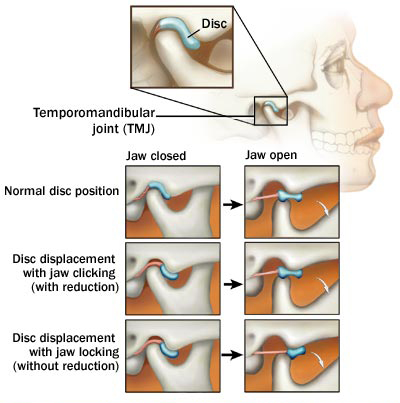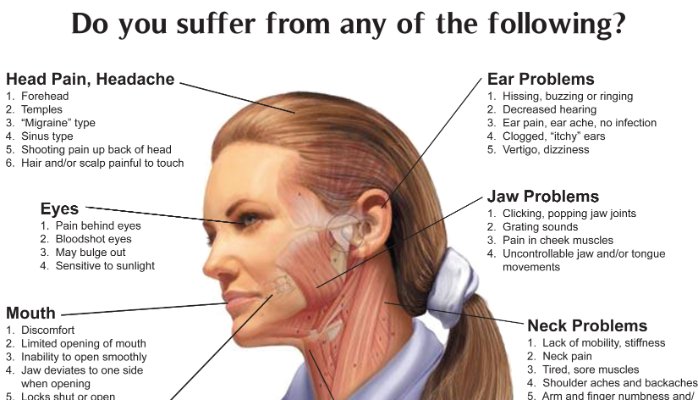What is TMJ / TMD?
The Jaw Joint aka “TMJ”
The “Temporomandibular Joint,” more commonly referred to as the “jaw joint,” assists in the basic opening and closing movements of the jaw. Unfortunately, this joint is a common area for recurring pain. Although conventional wisdom suggests that “popping” sounds in the jaw indicates a TMJ dysfunction, this is not always true. Many times, your jaw is functioning properly even if a “popping” sound is present when chewing or talking.
Signs and symptoms
A TMD is a condition, not a specific disease. Temporomandibular disorders can have many different signs and symptoms, from mild to severe. Some patients may have symptoms but are still able to function fully. TMDs appear to be more common in women. Specific symptoms may include:
- pain in or around the ear
- tender jaw muscles
- clicking or popping noises in the jaw
- difficulty opening or closing the mouth
- pain when yawning or chewing
- jaw joints that feel as if they are “locked,” “stuck” or they “go out”
- headaches
The “Temporomandibular Joint,” more commonly referred to as the “jaw joint,” assists in the basic opening and closing movements of the jaw. Unfortunately, this joint is a common area for recurring pain. Although conventional wisdom suggests that “popping” sounds in the jaw indicates a TMJ dysfunction, this is not always true. Many times, your jaw is functioning properly even if a “popping” sound is present when chewing or talking.
What causes TMD?
Several conditions may be linked with TMD. This often makes it difficult to pinpoint the cause of a particular case of TMD. Related conditions may include:
- jaw or head injuries
- diseases that affect the muscles or joints, such as arthritis
- tooth grinding
- stress
- sleep disorders
To determine how best to treat your condition, a complete evaluation is recommended. This will include:
- complete review of medical history
- examine the joints and muscles for tenderness, clicking, popping or difficulty moving.
- x-rays of the joint
- models of your teeth to see how your bite fits together

How the jaw joints and muscles work
The joints and muscles on each side of your jaw help open and close the mouth. These joints move in many different directions. They allow you to chew, talk and swallow.
The two temporomandibular joints are among the most complex joints in the body. They work together in a delicate balance with muscles, ligaments, cartilage and your jaw bones. They are the only 2 joints in the body which must work in the exact same motion at the same time. When a problem prevents these parts from working together properly, pain may result.
The “Temporomandibular Joint,” more commonly referred to as the “jaw joint,” assists in the basic opening and closing movements of the jaw. Unfortunately, this joint is a common area for recurring pain. Although conventional wisdom suggests that “popping” sounds in the jaw indicates a TMJ dysfunction, this is not always true. Many times, your jaw is functioning properly even if a “popping” sound is present when chewing or talking.
Treatment Options
For some patients, the disorders may disappear by themselves; for others, they may come and go, or may worsen over time. TMD disorders are often managed, rather than cured.
There are several ways TMD may be managed. The success of the treatment often depends upon you and your dentist working together to find what works to relieve your symptoms.
Treatment may involve a series of steps. The step-by-step plan allows you to try simple treatment before moving on to more involved treatment. Experts generally recommend a “less is often best” approach to treating TMJ disorders.
We offer a TMJ exam that evaluates the joint tissue in the “hinge” of the jaw. Possible problems include swelling, deterioration of the joint tissue or damaged joint tissue, which cushions the jaw bones during the opening and closing movement of the mouth. Common pain relievers (such as ibuprofen) and cold compresses can provide temporary relief for most cases of TMJ.
The following self-care practices may be recommended:
- eating softer foods or avoiding foods that cause symptoms
- minimize extreme jaw movements, such as yawning, yelling or singing
- avoid chewing gum
- modifying the pain with heat or ice packs
- practicing relaxation techniques to control jaw tension, such as meditation
If necessary, your dentist may recommend the following to relieve your symptoms:
- exercises to strengthen jaw muscles
- medicines to reduce pain or inflammation, or to help you relax
- a night guard or bite plate to decrease clenching or grinding of teeth
- adjusting or reshaping some teeth
- orthodontic evaluation of bite stability



